Application of Silver Nanoparticles Supported over Mesoporous Carbon Produced from Sustainable Sources as Catalysts for Hydrogen Production
Abstract
:1. Introduction
2. Experimental
2.1. Synthesis
2.2. Characterization
2.3. Catalytic Tests
2.4. Catalyst Reusability
3. Results/Discussions
3.1. Catalyst Characterization
3.2. Catalytic Tests
3.3. Catalytic Reusability Tests
4. Conclusions
Author Contributions
Funding
Data Availability Statement
Acknowledgments
Conflicts of Interest
References
- World Energy Council. World Energy Resources 2016 Report; Report No. 24; World Energy Council: London, UK, 2016. [Google Scholar]
- Shafiee, S.; Topal, E. When will fossil fuel reserves be diminished? Energy Policy 2008, 37, 181–189. [Google Scholar] [CrossRef]
- Raupach, M.R.; Marland, G.; Ciais, P.; Le Quéré, C.; Canadell, J.G.; Klepper, G.; Field, C.B. Global and regional drivers of accelerating CO2 emissions. Proc. Natl. Acad. Sci. USA 2007, 104, 10288–10293. [Google Scholar] [CrossRef] [PubMed]
- Veziroglu, T.N. 21st Century’s Energy: Hydrogen Energy System. Assess. Hydrog. Energy Sustain. Dev. NAPSC 2007, 4, 9–31. [Google Scholar] [CrossRef]
- Xia, Y.; Yang, Z.; Mokaya, R. Simultaneous Control of Morphology and Porosity in Nanoporous Carbon: Graphitic Mesoporous Carbon Nanorods and Nanotubules with Tunable Pore size. Chem. Mater. 2005, 18, 140–148. [Google Scholar] [CrossRef]
- Liang, C.; Li, Z.; Dai, S. Mesoporous Carbon Materials: Synthesis and Modification. Angew. Chem. Int. 2008, 47, 3696–3717. [Google Scholar] [CrossRef] [PubMed]
- Horváth, E.; Puskás, R.; Rémiás, R.; Mohl, M.; Kukovecz, Á.; Kónya, Z.; Kiriesi, I. A Novel Catalyst Type Containing Noble Metal Nanoparticles Supported on Mesoporous Carbon: Synthesis, Characterization and Catalytic properties. Top Catal. 2009, 52, 1242–1250. [Google Scholar] [CrossRef]
- Chang, H.; Joo, S.H.; Pak, C. Synthesis and characterization of mesoporous carbon for fuel cell applications. J. Mater. Chem. 2007, 17, 3078–3088. [Google Scholar] [CrossRef]
- Xia, Y.; Mokaya, R. Generalized and Facile Synthesis Approach to N-Doped Highly Graphitic Mesoporous Carbon Materials. Chem Mater. 2005, 17, 1553–1560. [Google Scholar] [CrossRef]
- Su, F.; Zeng, J.; Bao, X.; Yu, Y.; Lee, J.Y.; Zhao, X.S. Preparation and Characterization of Highly Ordered Graphitic Mesoporous Carbon as a Pt Catalyst Support for Direct Methanol Fuel Cells. Chem. Mater. 2005, 17, 3960–3967. [Google Scholar] [CrossRef]
- Matos, I.; Bernardo, M.; Neves, P.D.; Castanheiro, J.E.; Vital, J.; Fonseca, I.M. Mesoporous Carbon as effective and sustainable catalyst for fine chemistry. Bol. Grupo Español Carbón 2016, 39, 19–22. [Google Scholar]
- Budarin, V.; Clark, J.H.; Hardy, J.J.E.; Luque, R.; Milkowski, K.; Tavener, S.J.; Wilson, A.J. Starbons: New Starch-Derived Mesoporous Carbonaceous Materials with Tunable Properties. Angew. Int. Ed. 2007, 45, 3782–3786. [Google Scholar] [CrossRef] [PubMed]
- Biehler, E.; Quach, Q.; Abdel-Fattah, T. Screening study of Different Carbon Based Materials for Hydrogen. ECS J. Solid State Sci. Technol. 2023, 12, 081002. [Google Scholar] [CrossRef]
- Shuttleworth, P.S.; Budarin, V.; White, R.J.; Gun’ko, V.M.; Luque, R.; Clark, J.H. Molecular-Level Understanding of the Carbonistation of Polysaccharides. Chem. Eur. J. 2013, 19, 9351–9357. [Google Scholar] [CrossRef] [PubMed]
- Milkowski, K.; Clark, J.H.; Doi, S. New materials based on renewable resources: Chemically modified highly porous starches and their composites with synthetic monomers. Green Chem. 2004, 6, 189–190. [Google Scholar] [CrossRef]
- Hussain, M.; Ihm, S. Synthesis, Characterization, and Hydrodesulfurization Activity of New Mesoporous Carbon Support Transition Metal Sulfide Catalysts. Ind. Eng. Chem. Res. 2009, 48, 698–707. [Google Scholar] [CrossRef]
- Gupta, G.; Slanac, D.A.; Kumar, P.; Wiggins-Camacho, J.D.; Kim, J.; Ryoo, R.; Stevenson, K.J.; Johnston, K.P. Highly Stable Pt/Ordered Graphitic Mesoporous Carbon Electrocatalysts for Oxidation Reduction. J. Phys. Chem. C 2010, 114, 10796–10805. [Google Scholar] [CrossRef]
- Wen, Z.; Liu, J.; Li, J. Core/Shell Pt/C Nanoparticle Embedded in Mesoporous Carbon as a Methanol-Tolerant Cathode Catalyst in Direct Methanol fuel Cells. J. Adv. Mater. 2008, 20, 743–747. [Google Scholar] [CrossRef]
- Kholoud, M.M.; El-Nour, A.; Eftaiha, A.; Al-Warthan, A.; Ammar, R.A.A. Synthesis and applications of silver nanoparticles. Arabian J. Chem. 2010, 3, 135–140. [Google Scholar]
- Dushatinski, T.; Huff, C.; Abdel-Fattah, T.M. Characterization of electrochemically deposited films from aqueous and ionic liquid cobalt precursors toward hydrogen evolution reactions. Appl. Surf. Sci. 2016, 385, 282–288. [Google Scholar] [CrossRef]
- Datta, K.K.R.; Reddy, B.V.S.; Ariga, K.; Vinu, A. Gold Nanoparticles Embedded in a Mesoporous Carbon Nitride Stabilizer for Highly Efficent Three-Component Coupling Reaction. Angew. Chem. 2010, 122, 6097–6101. [Google Scholar] [CrossRef]
- Gan, X.; Liu, T.; Zhong, J.; Li, G. Effect of Silver Nanoparticles on Electron Transfer Reactivity and the Catalytic Activity of Myoglobin. ChemBioChem 2004, 5, 1686–1691. [Google Scholar] [CrossRef] [PubMed]
- Xu, R.; Wang, D.; Zhang, J.; Li, Y. Shape-Dependent Catalytic Activity of Silver Nanoparticles for the Oxidation of Styrene. Chem. Asian J. 2006, 1, 888–893. [Google Scholar] [CrossRef] [PubMed]
- Beck, J.S.; Vartuli, J.C.; Roth, W.J.; Leonowicz, M.E.; Kresge, C.T.; Schmitt, K.D.; Chu, C.T.W.; Olson, D.H.; Sheppard, E.W.; McCullen, S.B.; et al. A new family of mesoporous molecular sieves prepared with liquid crystal templates. J. Am. Chem. Soc. 1992, 114, 10834–10843. [Google Scholar] [CrossRef]
- Comotti, M.; Pina, C.D.; Matarrese, R.; Rossi, M. The Catalytic Activity of “Naked” Gold Particles. Angew. Chem. Int. Ed. 2004, 43, 5812–5815. [Google Scholar] [CrossRef] [PubMed]
- Huff, C.; Dushatinski, T.; Abdel-Fattah, T.M. Gold nanoparticle/multi-walled carbon nanotube composite as novel catalyst for hydrogen evolution reactions. Int. J. Hydrogen Energy 2017, 42, 18985–18990. [Google Scholar] [CrossRef]
- Kim, M.; Sohn, K.; Bin Na, H.; Hyeon, T. Synthesis of Nanorattles Composed of Gold Nanoparticles Encapsulated in Mesoporous Carbon and Polymer Shells. Nano Lett. 2002, 2, 1383–1387. [Google Scholar] [CrossRef]
- Liang, M.; Su, R.; Qi, W.; Yu, Y.; Wang, L.; He, Z. Synthesis of well-dispersed Ag nanoparticles on eggshell membrane for catalytic reduction of 4-nitrophenol. J. Mater. Sci. 2014, 49, 1639–1647. [Google Scholar] [CrossRef]
- Lopez, N.; Janssens, T.V.W.; Clausen, B.S.; Xu, Y.; Mavrikakis, M.; Bligaard, T.; Nørskov, J.K. On the origin of the catalytic activity of gold nanoparticles for low-temperature CO oxidation. J. Catal. 2004, 223, 232–235. [Google Scholar] [CrossRef]
- Daté, M.; Okumura, M.; Tsubota, S.; Haruta, M. Vital Role of Moisture in the Catalytic Activity of Supported Gold Nanoparticles. Angew. Chem. Int. Ed. 2004, 43, 2129–2132. [Google Scholar] [CrossRef]
- Seo, Y.; Hwang, J.; Kim, J.; Jeong, Y.; Hwang, M.P.; Choi, J. Antibacterial activity and cytotoxicity of multi-walled carbon nanotubes decorated with silver nanoparticles. Int. J. Nanomed. 2014, 9, 4621–4629. [Google Scholar]
- Sudrik, S.G.; Chaki, N.K.; Chavan, V.B.; Chavan, S.P.; Chavan, S.P.; Sonawane, H.R.; Vijayamohanan, K. Silver Nanocluster Redox-Couple-Promoted Nonclassical Electron Transfer: An Efficient Electrochemical Wolff Rearrangement of α-Diazoketones. Chem.—Eur. J. 2006, 12, 859–864. [Google Scholar] [CrossRef] [PubMed]
- Mitsudome, T.; Mikami, Y.; Mori, H.; Arita, S.; Mizugaki, T.; Jitsukawa, K.; Kaneda, K. Supported Silver Nanoparticle Catalyst for Selective Hydration of Nitriles to Amides in Water. Chem. Commun. 2009, 2009, 3258. [Google Scholar] [CrossRef] [PubMed]
- Mitsudome, T.; Mikami, Y.; Funai, H.; Mizugaki, T.; Jitsukawa, K.; Kaneda, K. Oxidant-Free Alcohol Dehydrogenation Using a Reusable Hydrotalcite-Supported Silver Nanoparticle Catalyst. Angew. Chem. Int. Ed. 2008, 47, 138–141. [Google Scholar] [CrossRef] [PubMed]
- Huff, C.; Long, J.M.; Abdel-Fattah, T.M. Beta-cyclodextrin-assisted synthesis of silver nanoparticle network and its application in a hydrogen generation reaction. Catalysts 2020, 10, 1014. [Google Scholar] [CrossRef]
- Pillai, Z.S.; Kamat, P.V. What Factors Control the Size and Shape of Silver Nanoparticles in the Citrate Ion Reduction Method? J. Phys. Chem. B 2004, 108, 945–951. [Google Scholar] [CrossRef]
- Huff, C.; Dushatinski, T.; Barzanji, A.; Abdel-Fattah, N.; Barzanji, K.; Abdel-Fattah, T.M. Pretreatment of Gold Nanoparticle Multi-Walled Carbon Nanotube Composites for Catalytic Activity toward Hydrogen Generation Reaction. ECS J. Solid State Sci. Technol. 2017, 6, 69–71. [Google Scholar] [CrossRef]
- Antolini, E.; Cardellini, F. Formation of carbon supported PtRu alloys: An XRD analysis. J. Alloys Compd. 2001, 315, 118–122. [Google Scholar] [CrossRef]
- Schlesinger, H.I.; Brown, H.C.; Finholt, A.E.; Gilbreath, J.R.; Hoekstra, H.R.; Hyde, E.K. Sodium borohydride, its hydrolysis and its use as a reducing agent and in the generation of hydrogen. J. Am. Chem. Soc. 1953, 75, 215–219. [Google Scholar] [CrossRef]
- Kaufman, C.M.; Sen, B. Hydrogen Generation by Hydrolysis of Sodium Tetrahydroborate: Effects of Acids and Transition Metals and Their Salts. J. Chem. Soc. Dalton Trans. 1985, 1985, 307–313. [Google Scholar] [CrossRef]
- Huff, C.; Long, J.M.; Aboulatta, A.; Heyman, A.; Abdel-Fattah, T.M. Silver Nanoparticle/Multi-Walled Carbon Nanotube Composite as Catalyst for Hydrogen Production. ECS J. Solid State Sc. 2017, 6, 115–118. [Google Scholar] [CrossRef]
- Huff, C.; Long, J.M.; Heyman, A.; Abdel-Fattah, T.M. Palladium Nanoparticle Multiwalled Carbon Nanotube Composite as Catalyst for Hydrogen Production by the Hydrolysis of Sodium Borohydride. ACS Appl. Energy Mater. 2018, 1, 4635–4640. [Google Scholar] [CrossRef]
- Quach, Q.; Biehler, E.; Elzamzami, A.; Huff, C.; Long, J.M.; Abdel-Fattah, T.M. Catalytic Activity of Beta-Cyclodextrin-Gold Nanoparticles Network in Hydrogen Evolution Reaction. Catalysts 2021, 11, 118. [Google Scholar] [CrossRef]
- Huff, C.; Biehler, E.; Quach, Q.; Long, J.M.; Abdel-Fattah, T.M. Synthesis of Highly Dispersive Platinum Nanoparticles and their Application in a Hydrogen Generation Reaction. Colloids Surf. A Physicochem. Eng. Asp. 2020, 610, 125734. [Google Scholar] [CrossRef]
- Huang, Y.; Wang, Y.; Zhao, R.; Shen, P.K.; Wei, Z. Accurately measuring the hydrogen generation rate for hydrolysis of sodium borohydride on multi-walled carbon nanotubes/Co-B catalysts. Int. J. Hydrogen Energy 2008, 33, 7110–7115. [Google Scholar] [CrossRef]
- Jeong, S.U.; Kim, R.K.; Cho, E.A.; Kim, H.-J.; Nam, S.-W.; Oh, I.-H.; Hong, S.-A.; Kim, S.H. A study on hydrogen generation from NaBH4 solution using the high-performance Co-B catalyst. J. Power Sources 2005, 144, 129–134. [Google Scholar] [CrossRef]
- Levy, A.; Brown, J.B.; Lyons, C.J. Catalyzed Hydrolysis of Sodium Borohydride. Ind. Eng. Chem. 1960, 52, 211–214. [Google Scholar] [CrossRef]
- Manna, J.; Roy, B.; Sharma, P. Efficient hydrogen generation from sodium borohydride hydrolysis using silica sulfuric acid catalyst. J. Power Sources 2015, 275, 727–733. [Google Scholar] [CrossRef]
- Liang, Y.; Dai, H.-B.; Ma, L.-P.; Wang, P.; Cheng, H.-M. Hydrogen generation from sodium borohydride solution using a ruthenium supported graphite catalyst. Int. J. Hydrogen Energy 2010, 35, 3023–3028. [Google Scholar] [CrossRef]
- Zhang, J.S.; Delgass, W.N.; Fisher, T.S.; Gore, J.P. Kinetics of Ru-catalyzed sodium borohydride hydrolysis. J. Power Sources 2007, 164, 772–781. [Google Scholar] [CrossRef]
- Patel, N.; Patton, B.; Zanchetta, C.; Fernandes, R.; Guella, G.; Kale, A.; Miotello, A. Pd-C power and thin film catalysts for hydrogen production by hydrolysis of sodium borohydride. Int. J. Hydrogen Energy 2008, 33, 287–292. [Google Scholar] [CrossRef]
- Peña-Alonso, R.; Sicurelli, A.; Callone, E.; Carturan, G.; Raj, R. A picoscale catalyst for hydrogen generation from NaBH4 for fuel cells. J. Power Sources 2007, 165, 315–323. [Google Scholar] [CrossRef]
- Biehler, E.; Quach, Q.; Abdel-Fattah, T.M. Synthesis of Platinum Nanoparticles Supported on Fused Nanosized Carbon Spheres Derived from Sustainable Source for Application in a Hydrogen Generation Reaction. Nanomaterials 2023, 13, 1994. [Google Scholar] [CrossRef]
- Biehler, E.; Quach, Q.; Abdel-Fattah, T.M. Silver-Nanoparticle-Decorated Fused Carbon Sphere Composite as a Catalyst for Hydrogen Generation. Energies 2023, 16, 5053. [Google Scholar] [CrossRef]
- Quach, Q.; Biehler, E.; Abdel-Fattah, T.M. Synthesis of Palladium Nanoparticles Supported over Fused Graphene-like Material for Hydrogen Evolution Reaction. Catalysts 2023, 13, 1117. [Google Scholar] [CrossRef]
- Biehler, E.; Quach, Q.; Abdel-Fattah, T.M. Gold Nanoparticles AuNP Decorated on Fused Graphene-like Materials for Application in a Hydrogen Generation. Materials 2023, 16, 4779. [Google Scholar] [CrossRef] [PubMed]
- Quach, Q.; Biehler, E.; Abdel-Fattah, T.M. Synthesis of Copper Nanoparticles Supported over Graphene-like Material Composite as a Catalyst for Hydrogen Evolution. J. Compos. Sci. 2023, 7, 279. [Google Scholar] [CrossRef]
- Deraedt, C.; Salmon, L.; Gatard, S.; Ciganda, R.; Hernandez, E.; Ruiz, J.; Astruc, D. Sodium borohydride stabilizes very active gold nanoparticle catalysts. Chem. Commun. 2014, 50, 14194–14196. [Google Scholar] [CrossRef] [PubMed]
- Abdel-Fattah, T.M.; Biehler, E. Carbon Based Supports for Metal Nanoparticles for Hydrogen Generation Reactions Review. Adv. Carbon J. 2024, 1, 1–19. [Google Scholar] [CrossRef]
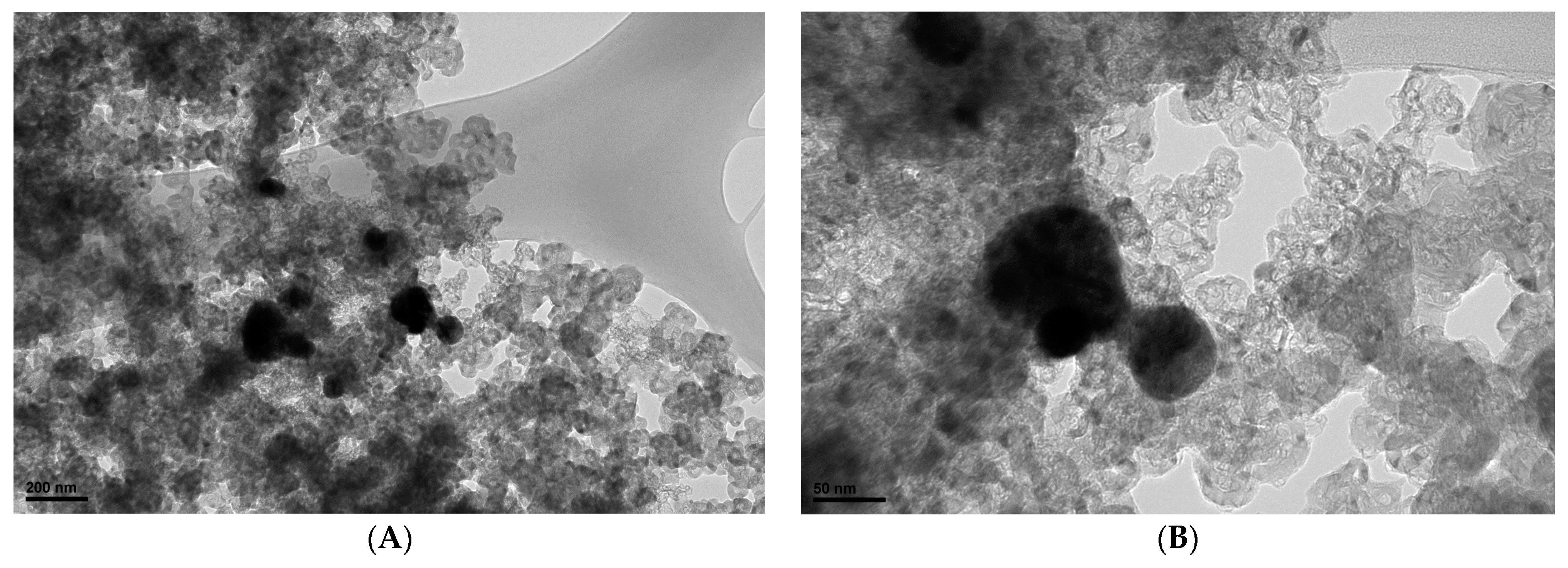
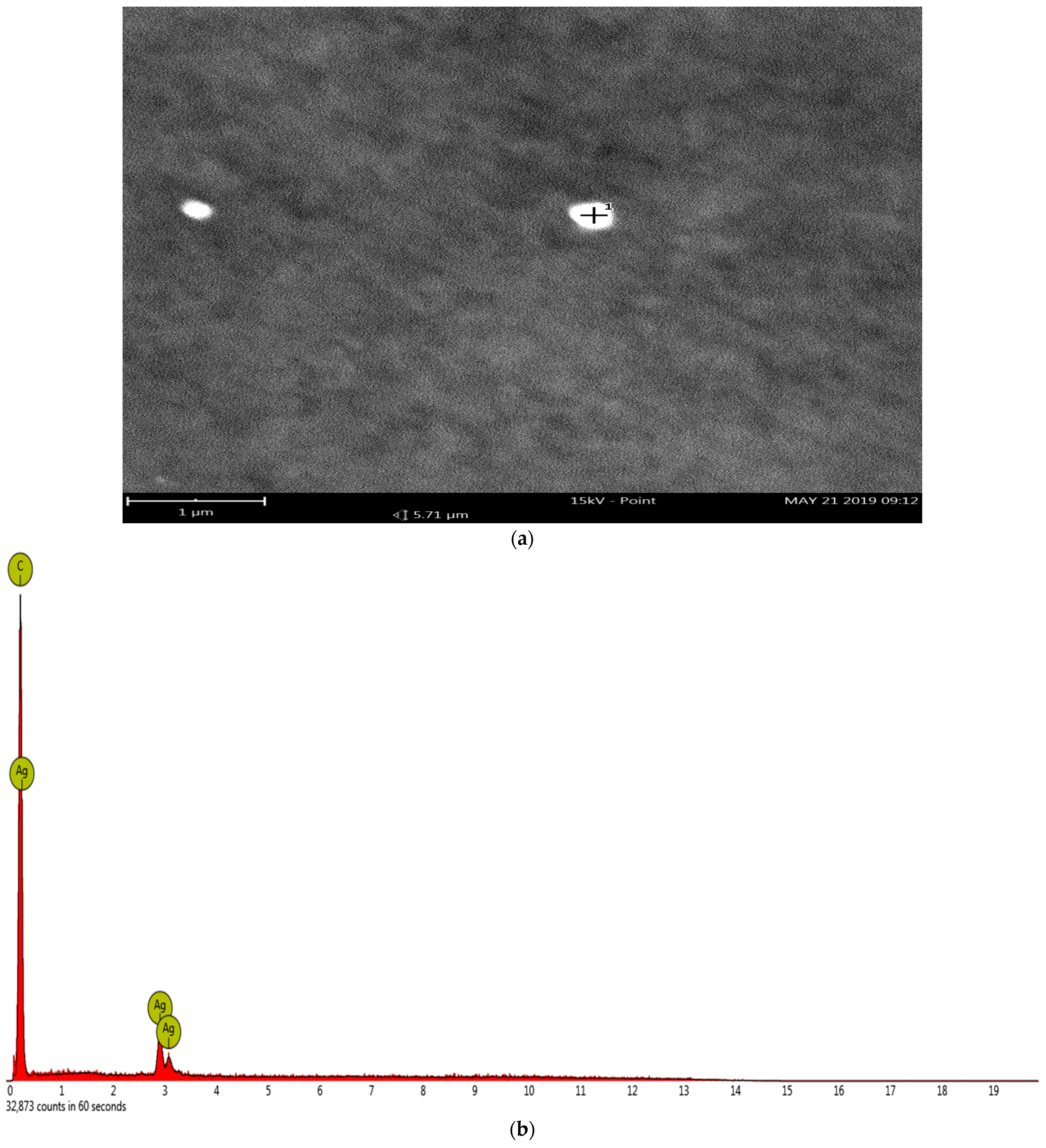
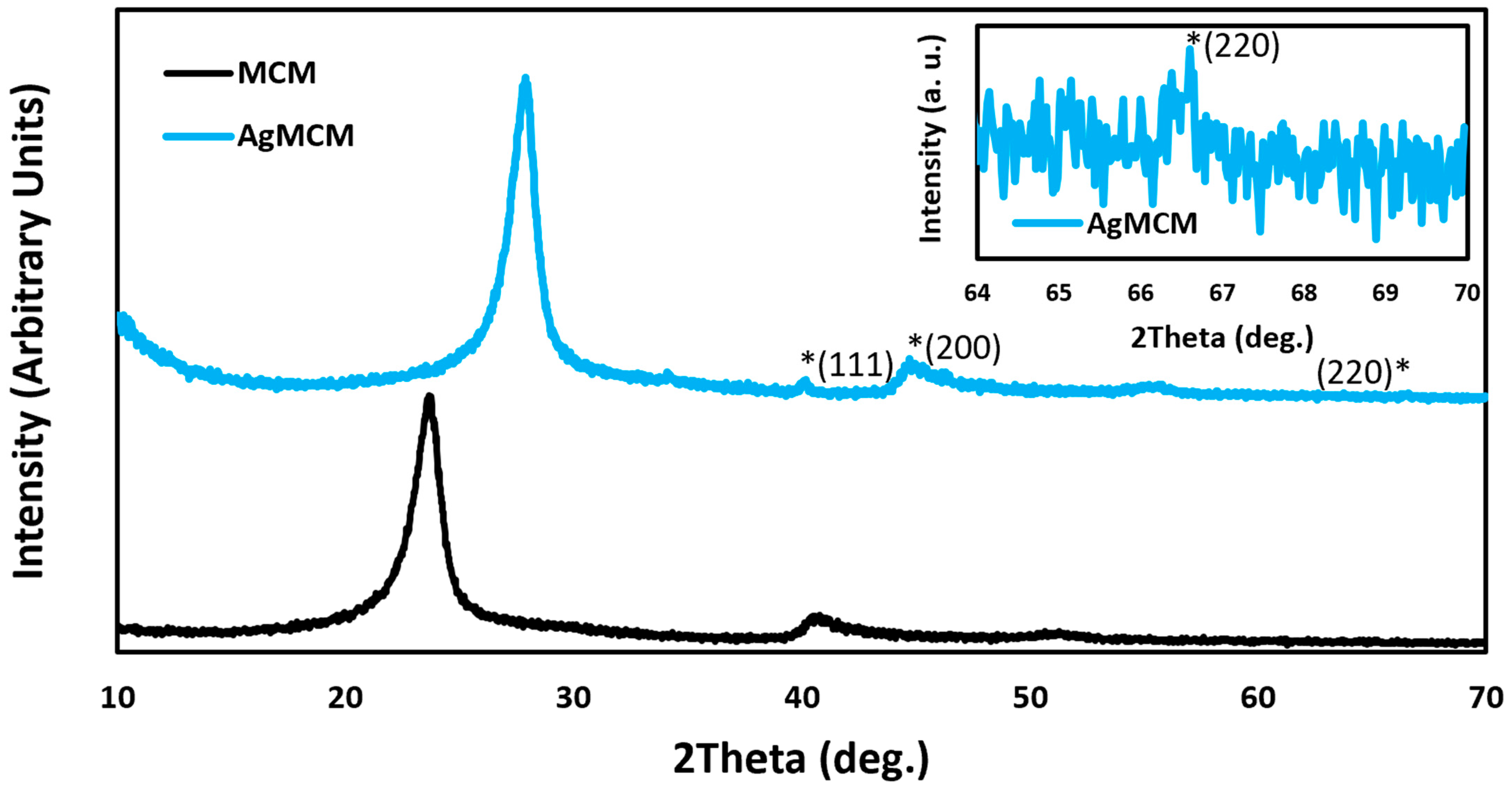
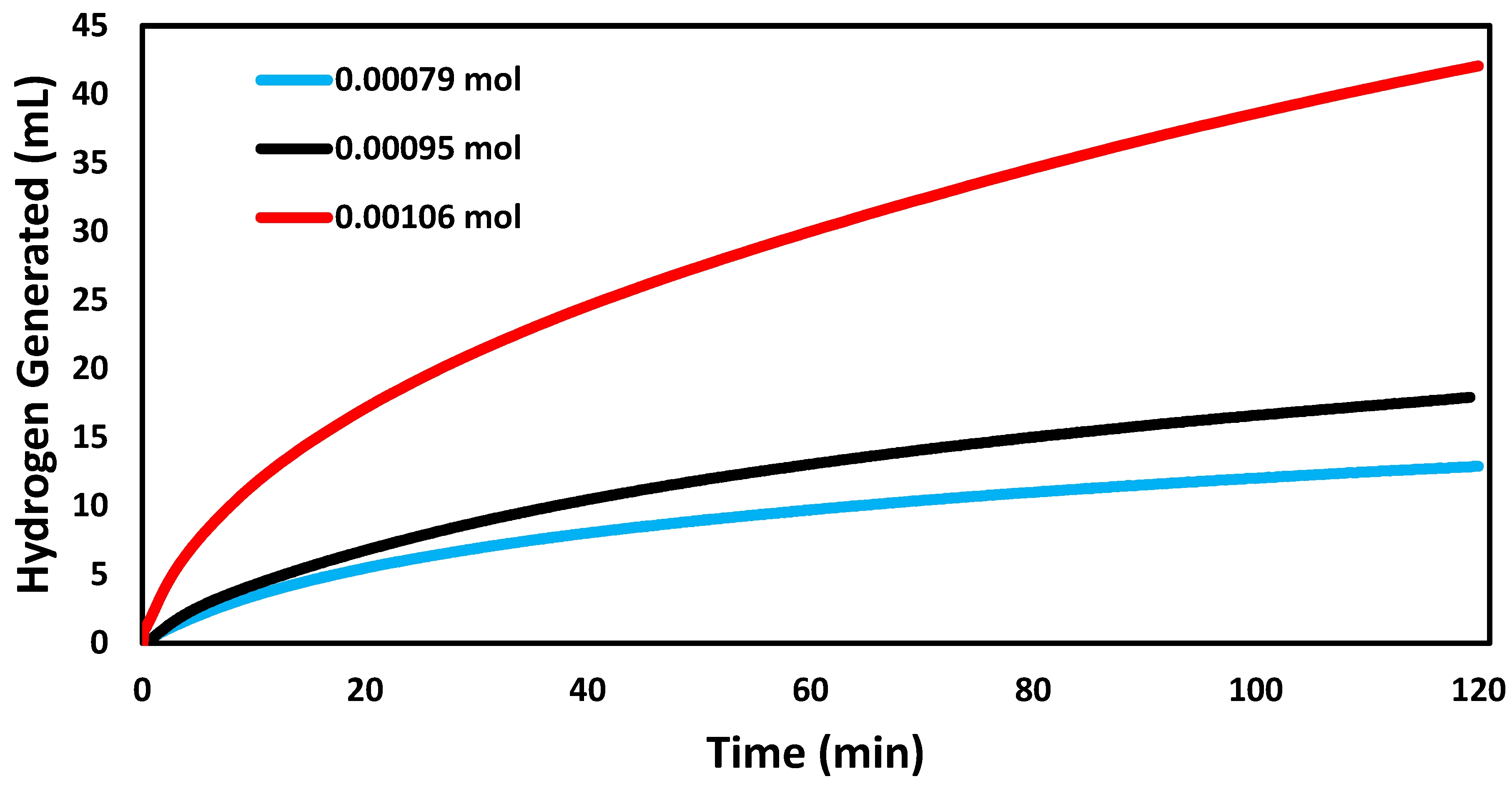

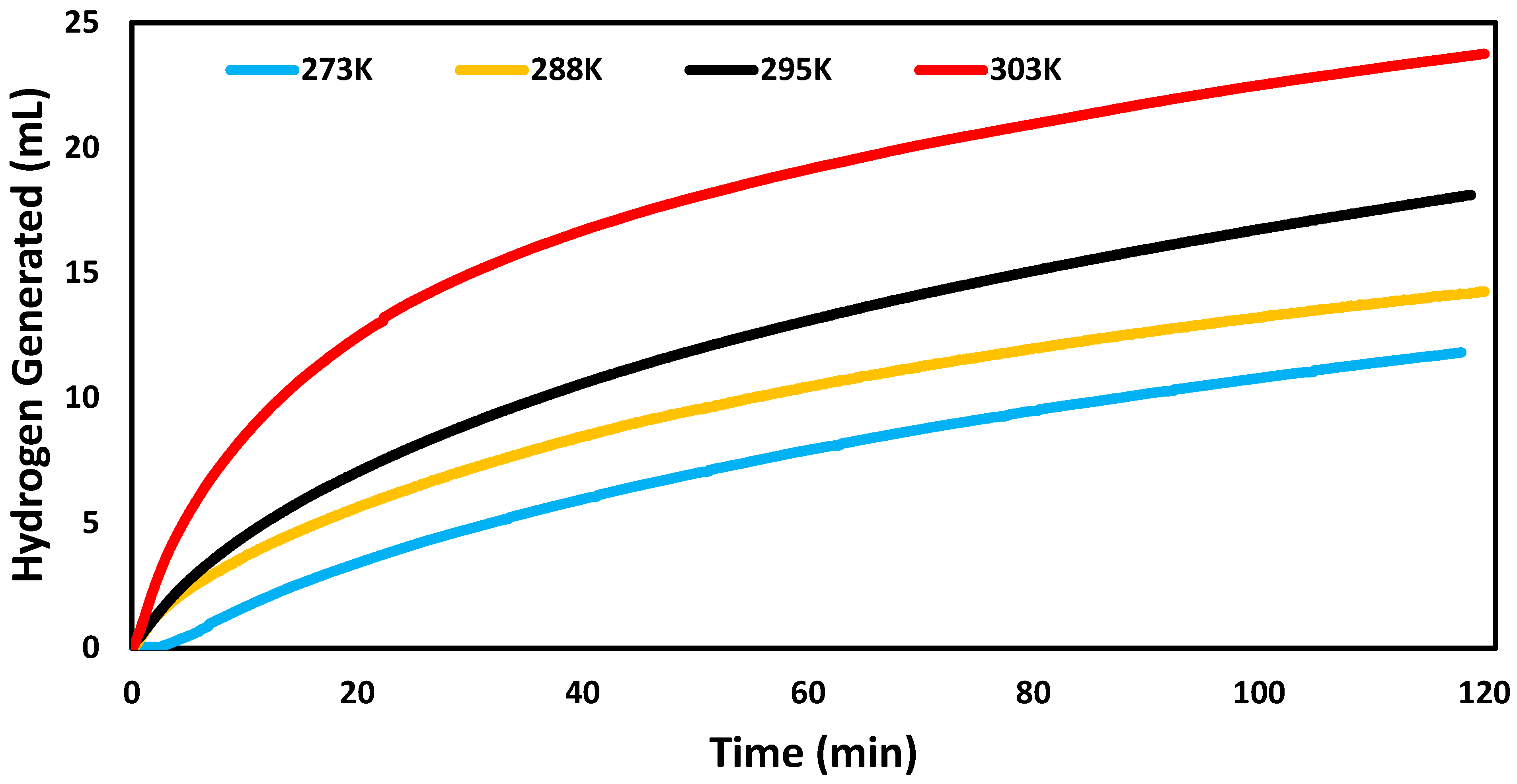

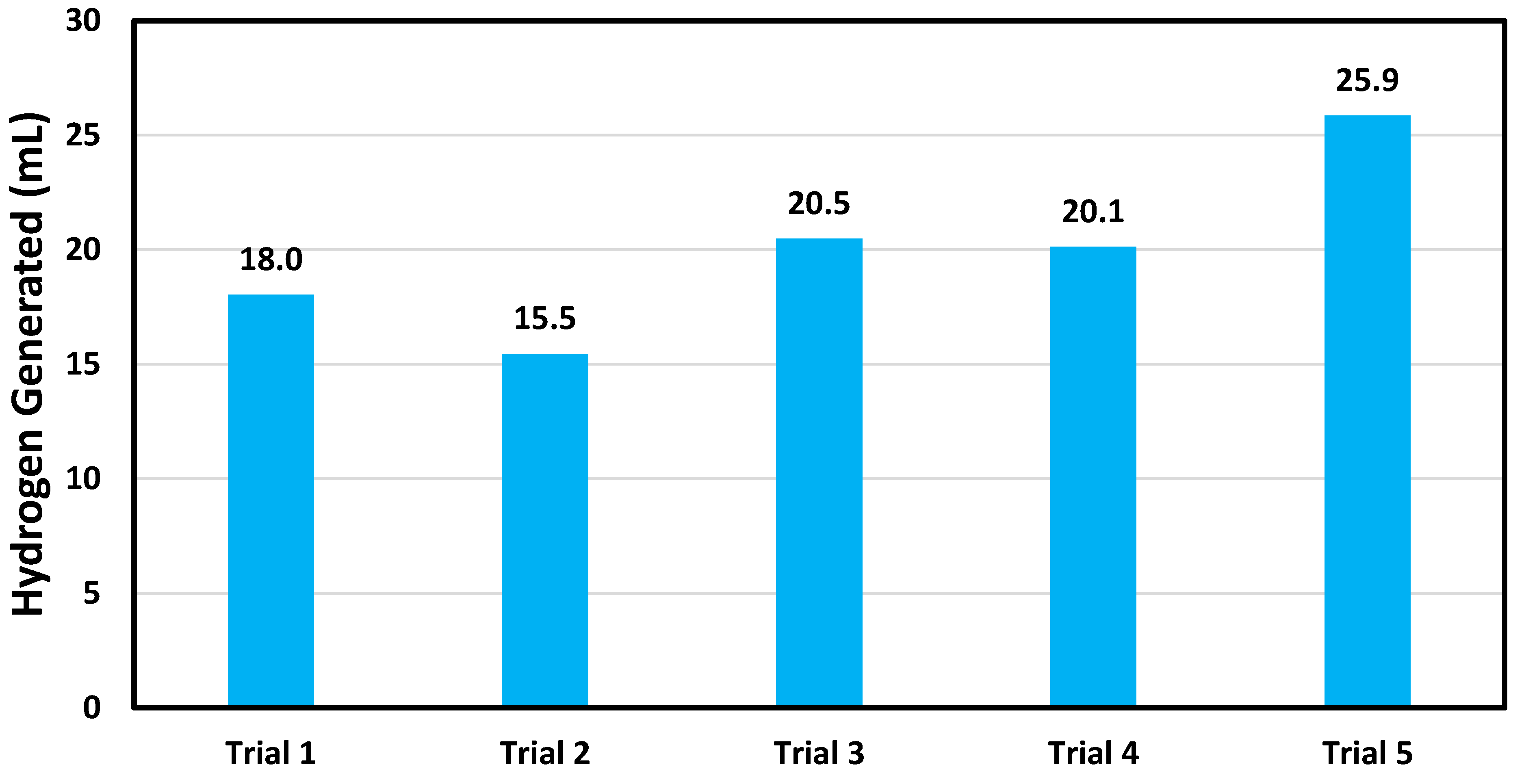

| Catalyst | Ea (kJ mol−1) | Temperature (K) | Reference |
|---|---|---|---|
| MWCNT supported Co | 40.4 | 298–333 | [45] |
| Co-B | 64.9 | 283–303 | [46] |
| CoCl2 | 17.5 | 293–308 | [47] |
| Silica sulfuric acid | 17 | 298–343 | [48] |
| Ru/Graphite | 61.1 | 398–318 | [49] |
| Ru/C | 67 | 298–358 | [50] |
| Pd/C | 28 | 298–328 | [51] |
| Pt–Pd/CNTs | 19 | 302–332 | [52] |
| Au/MWCNTs | 21.1 | 273–303 | [26] |
| Ag/MWCNTs | 44.5 | 273–303 | [41] |
| Pd/MWCNTs | 62.7 | 273–303 | [42] |
| BCD-AuNP | 54.7 | 283–303 | [43] |
| PtNPs | 39.2 | 283–303 | [44] |
| PtFCS | 53.0 | 283–303 | [53] |
| AgNP-FCS | 37.0 | 273–303 | [54] |
| PdFGLM | 45.1 | 283–303 | [55] |
| AuFGLM | 45.5 | 283–303 | [56] |
| CuGLM | 46.8 | 283–303 | [57] |
| Ag-MCM | 15.6 | 273–303 | This Work |
Disclaimer/Publisher’s Note: The statements, opinions and data contained in all publications are solely those of the individual author(s) and contributor(s) and not of MDPI and/or the editor(s). MDPI and/or the editor(s) disclaim responsibility for any injury to people or property resulting from any ideas, methods, instructions or products referred to in the content. |
© 2024 by the authors. Licensee MDPI, Basel, Switzerland. This article is an open access article distributed under the terms and conditions of the Creative Commons Attribution (CC BY) license (https://creativecommons.org/licenses/by/4.0/).
Share and Cite
Biehler, E.; Quach, Q.; Abdel-Fattah, T.M. Application of Silver Nanoparticles Supported over Mesoporous Carbon Produced from Sustainable Sources as Catalysts for Hydrogen Production. Energies 2024, 17, 3327. https://doi.org/10.3390/en17133327
Biehler E, Quach Q, Abdel-Fattah TM. Application of Silver Nanoparticles Supported over Mesoporous Carbon Produced from Sustainable Sources as Catalysts for Hydrogen Production. Energies. 2024; 17(13):3327. https://doi.org/10.3390/en17133327
Chicago/Turabian StyleBiehler, Erik, Qui Quach, and Tarek M. Abdel-Fattah. 2024. "Application of Silver Nanoparticles Supported over Mesoporous Carbon Produced from Sustainable Sources as Catalysts for Hydrogen Production" Energies 17, no. 13: 3327. https://doi.org/10.3390/en17133327






